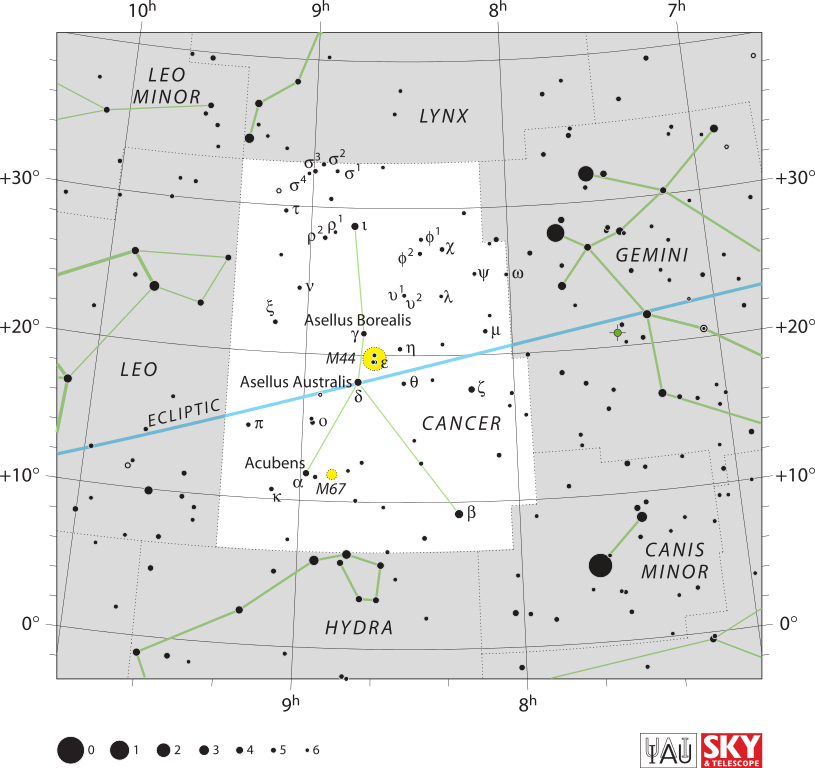
These next few nights – March 23 and 24, 2021 – the bright waxing gibbous moon puts the constellation Cancer the Crab simultaneously in the spotlight and out of view. That is, the moon is in front of Cancer’s stars, so you won’t see this constellation, the faintest of the constellations of the zodiac, visible only on dark, moonless nights. Still, if you notice the stars around the moon these next few nights, they can help you find Cancer.
By early April, when we’re past full moon and the moon is leaving the evening sky, Cancer the Crab will be showing its delicate starlit figure in the region of sky in between the Leo star Regulus and the Gemini stars Castor and Pollux.
Identify Regulus, Castor and Pollux now, and you can use them for years to come to help you identify Cancer.
Our featured chart at top shows the moon and Cancer for North American mid-northern latitudes. As seen from Europe and Asia, though, the moon is offset toward the Gemini stars, Castor and Pollux. This difference in the moon’s position, relative to the backdrop stars of the zodiac, is due to the moon’s own motion in orbit around Earth.

The constellation Cancer via the International Astronomical Union (IAU). On a dark night, look for the Beehive star cluster (M44) to make a triangle with the Gemini stars, Castor and Pollux, and the bright star Procyon.
From the Southern Hemisphere, the differences are due in part to the moon’s movement, and in part to the difference in perspective from one hemisphere to the other. Still, we all live under the same sky, and no matter where you live worldwide, the moon beams in the vicinity of Cancer for the next couple of nights, with the moon sandwiched in between Castor and Pollux on one side and the star Regulus on the other.
Just remember – although we outline Cancer for you on our chart, you’re not likely to see this constellation in the drenching moonlight. Notice the stars around the moon, and look again starting in late March and throughout the first two weeks of April. The moon will be gone by then, providing a dark evening sky for stargazing.
Bottom line: The waxing gibbous moon puts the constellation Cancer the Crab in the spotlight – but out of view – on the nights of March 23 and 24, 2021.
Cancer? Here’s your constellation
from EarthSky https://ift.tt/2NK3qdh

These next few nights – March 23 and 24, 2021 – the bright waxing gibbous moon puts the constellation Cancer the Crab simultaneously in the spotlight and out of view. That is, the moon is in front of Cancer’s stars, so you won’t see this constellation, the faintest of the constellations of the zodiac, visible only on dark, moonless nights. Still, if you notice the stars around the moon these next few nights, they can help you find Cancer.
By early April, when we’re past full moon and the moon is leaving the evening sky, Cancer the Crab will be showing its delicate starlit figure in the region of sky in between the Leo star Regulus and the Gemini stars Castor and Pollux.
Identify Regulus, Castor and Pollux now, and you can use them for years to come to help you identify Cancer.
Our featured chart at top shows the moon and Cancer for North American mid-northern latitudes. As seen from Europe and Asia, though, the moon is offset toward the Gemini stars, Castor and Pollux. This difference in the moon’s position, relative to the backdrop stars of the zodiac, is due to the moon’s own motion in orbit around Earth.

The constellation Cancer via the International Astronomical Union (IAU). On a dark night, look for the Beehive star cluster (M44) to make a triangle with the Gemini stars, Castor and Pollux, and the bright star Procyon.
From the Southern Hemisphere, the differences are due in part to the moon’s movement, and in part to the difference in perspective from one hemisphere to the other. Still, we all live under the same sky, and no matter where you live worldwide, the moon beams in the vicinity of Cancer for the next couple of nights, with the moon sandwiched in between Castor and Pollux on one side and the star Regulus on the other.
Just remember – although we outline Cancer for you on our chart, you’re not likely to see this constellation in the drenching moonlight. Notice the stars around the moon, and look again starting in late March and throughout the first two weeks of April. The moon will be gone by then, providing a dark evening sky for stargazing.
Bottom line: The waxing gibbous moon puts the constellation Cancer the Crab in the spotlight – but out of view – on the nights of March 23 and 24, 2021.
Cancer? Here’s your constellation
from EarthSky https://ift.tt/2NK3qdh

Aucun commentaire:
Enregistrer un commentaire